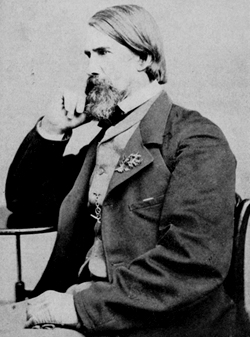January 19, 1812: John Aston Warder, Founder of the American Forestry Association, is Born
Happy birthday to Dr. John Aston Warder, founder of the American Forestry Association, and influential figure in the development of American horticulture and forestry.
 On this date in 1812, John Aston Warder was born near Philadelphia, Pennsylvania. The eldest son of Quakers Jeremiah and Ann Aston Warder, he developed a love of nature early in life, spending great amounts of time in the Pennsylvania woods near the family’s suburban home.
On this date in 1812, John Aston Warder was born near Philadelphia, Pennsylvania. The eldest son of Quakers Jeremiah and Ann Aston Warder, he developed a love of nature early in life, spending great amounts of time in the Pennsylvania woods near the family’s suburban home.
Warder attended Jefferson Medical College in Philadelphia, graduating in 1836 and establishing his medical practice in Cincinnati, Ohio. Warder would practice medicine in Cincinnati for almost 20 years, while at the same time maintaining active interest in his pursuits related to the natural world. He became involved with the Cincinnati Horticultural Society, the Cincinnati Society of Natural History, the Ohio Horticultural Society, the Ohio State Board of Agriculture, the Western Academy of Natural Sciences, and various other organizations. Warder also helped draw public attention to gardening and landscape design, advocating for the beautification of parks and cemeteries.
Increasingly drawn to these outside pursuits, Warder gave up his medical practice in 1855 and moved to a rural home in North Bend, Ohio on land overlooking the Ohio River that was once part of the farm of President Benjamin Harrison. There he practiced planting and gardening, and began a flurry of horticultural writings which were published over the next ten years.
During the 1860s Warder’s primary interest began to shift from horticulture to forestry. His work in this area led to his 1873 appointment as United States Commissioner to the International Exhibition (World’s Fair) in Vienna, where he wrote the the official report on forests and forestry. This report described the forestry exhibits of each country, presented detailed forest data, and made a great mass of European forestry knowledge available to Americans.
Warder was also one of the first people to propose planting protective belts of trees on the western plains of the U.S. to provide shelter from wind and protect the soil from erosion. In his 1858 work Hedges and Evergreens, Warder wrote:
The barrenness of the great Western plains of our continent is said to depend more upon their aridity, and the constant evaporation caused by the winds that sweep over their surface, than upon any deficiency in the soil. It has been suggested, that the first step toward the settlement of such a country would be, to plant belts of trees of the hardiest drought-enduring kinds. . .
Warder would further develop these theories and continue to publish materials on the need for shelterbelts during the subsequent decades.
In 1875, Warder issued a call for persons interested in forest planting and conservation to meet in Chicago. Those responding to this call met at the Grand Pacific Hotel on September 10, 1875, and there formed the American Forestry Association, with Warder selected as the group’s first president. The organization was further established at the second meeting in Philadelphia on September 15, 1876, where Warder was reelected as president. The formation of AFA proved to be a monumental moment in the history of forestry and conservation in this country, as it occurred prior to the existence of state and national forests, before forestry education programs in the U.S., and before the implementation of national forest policy. AFA was able to facilitate the advance of American forest management and conservation into the 20th century. Warder would remain as president until 1882, the year he helped merge AFA with the American Forestry Congress, further expanding the reach of the organization, which today is known as American Forests.
In 1883, Warder was chosen as Honorary President of the Ohio State Forestry Association. That same year he was also appointed agent of the Department of Agriculture to report on the Forestry of the Northwestern States. While still actively contributing to the advancement of American forestry, Warder was unfortunately slowed by an illness during this time period. Warder died on July 14, 1883 and was buried in Cincinnati’s Spring Grove Cemetery, a cemetery he himself had helped to design and landscape.
For more information relating to John Aston Warder, see the following collections from the FHS Archives:
- American Forestry Association Records, 1875-1997 (includes materials on the history of the organization)
- George H. Wirt Collection, 1873-1966 (includes an 1873 letter written by Warder, various speeches, and publications including the Report on Forests and Forestry from the 1873 Vienna Exposition)

